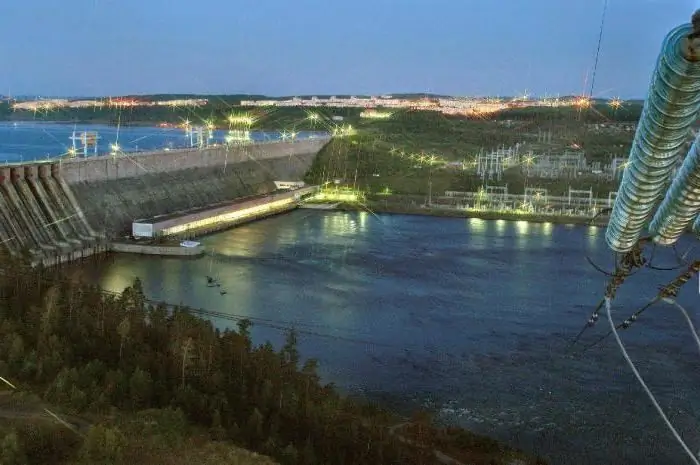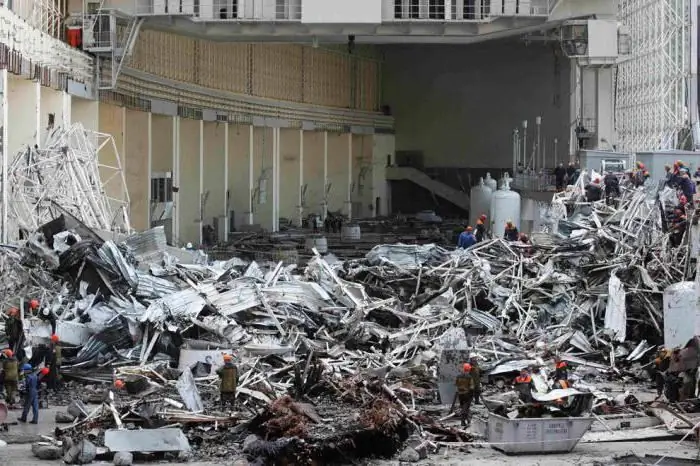2025 Author: Howard Calhoun | [email protected]. Last modified: 2025-01-24 13:10:35
HPP is an object erected on a river in order to convert the energy of its flow into electrical energy. One of the main structures of hydroelectric power plants in most cases is a dam that blocks the channel.
How HPP works
HPP is always a significant object for the economy of the state, among other things, which is also a symbol of industrial progress. But, despite the monumentality, such large-scale structures have a relatively simple principle of operation.
Initially, water at the hydroelectric power station comes to the blades of turbines installed in the engine room. The rotational energy of the latter is transferred to the generators. The generated electricity is supplied to the region's power transmission system.
The main characteristic of any hydropower plant is, of course, its capacity. And this factor, in turn, depends on the amount of water passing through the turbines and its pressure. The higher the last indicator, the higher the dam of the station.

Varieties of stations
Thus, a hydroelectric power station is a significant large-scale facility being built on a river. Currently, there are only two main types of hydroelectric power plants operating in the world:
- dam;
- derivational.
In the latter case, water pressure in a bypass channel or tunnel is used to generate electricity. Diversion HPPs are usually built on mountain rivers that are not too wide with strong currents.
Constructional elements of a conventional hydropower plant
In addition to the dam, during the construction of a hydroelectric power plant, structures such as:
- hydroelectric building;
- gateways;
- ship receivers and fish passages;
- spillway devices;
- switchgear.
In the power plant building there is an engine room with turbines and generators.

What is a derivation station
Such a hydroelectric power station is a special facility, always built on a channel with a large slope. The water in such rivers flows under strong pressure in a natural way, so in this case it is not necessary to equip a dam. The flow at such hydroelectric power plants goes directly to the main building to the turbines. A reservoir is usually created, but in most cases they have a very small area. Reservoirs are needed at hydroelectric power plants of this type solely to regulate the flow.
What hydropower plants are there in Russia?
Hydroelectric power plants in Russia, of course, a lot. Most of them have been functioning since the times of the USSR. The very first hydroelectric power station built on the territory of our country was Zyryanskaya. This facility was erected back in Tsarist Russia in 1892. It was a small station that provided electricity to the mine drainage of a local mine.
During the Soviet period, the government adopted the global GOERLO plan,according to which for 10-15 years it was supposed to build hydroelectric power stations in the country with a total capacity of 21254 thousand l / s. To date, the most significant hydroelectric power plants in the Russian Federation are:
- Sayano-Shushenskaya (Sayanogorsk) with a capacity of 6.4 GW;
- Krasnoyarsk (Divnogorsk) - 6 Guards;
- Bratskaya (Bratsk) - 4.52 Gw;
- Ust-Ilminskaya - 3.84 Gw;
- Boguchinskaya (Kodinsk) - 3 Guards;
- Zhigulevskaya - 2.4 GW;
- Bureiskaya - 2.01 Gw;
- Cheboksarskaya (Novocheboksarsk) - 1.4 Gw;
- Saratovskaya (Balakovo) - 1.38 Gw;
- Zeyskaya (Zeya) - 1.33 Gw;
The Nizhnekamsk HPP (Naberezhnye Chelny) is also a fairly large facility. The power of this station is 1.25 GW. The owner is OAO "Generation Company" and "Tatenergo". A station was built on the Kama River.

Sayano-Shushenskaya HPP: history
This hydroelectric power plant, which is part of the Yenisei cascade, is by far the largest in the country. Annually, on average, it generates about 23.5 billion kWh of electricity. The decision to build the Sayano-Shushenskaya station was made by the USSR government in 1961. The actual work on its construction began in 1968. In 1978, the Sayano-Shushenskoye reservoir was filled. The construction of the station was officially completed only in 2000.
The construction of the HPP was, unfortunately, accompanied by all sorts of troubles. During the construction process, spillway structures were destroyed several times, and cracks formed in the dam. However, in the end, judging by the reports of past years, all such problems were successfully resolved.
Station characteristics
The Sayano-Shushenskaya HPP is located near the village of Cheryomushki near the city of Sayanogorsk on the Yenisei River. Currently, 10 units are installed in its main building, each with a capacity of 640 MW. At the same time, unfortunately, there are only 8 units in working condition. The turbines at this station are very powerful, grade RO-230/833-0-677, operating at a design head of 194 meters. The height of the dam of this hydroelectric power station is 245 m. At the same time, the area of the reservoir formed as a result of the construction of the station is 621 km2.
During the construction of the Sayano-Shushenskaya HPP, a total of 35,600 hectares of farmland were flooded. At the same time, 2717 different kinds of buildings also had to be moved. The water in the reservoir of the hydroelectric power station is of good quality, therefore, in its lower part, several farms specializing in the production of trout were subsequently organized. The reservoir of the Sayano-Shushenskaya station is located simultaneously on the territory of three regions: Khakassia, Tuva and the Krasnoyarsk Territory. On its shores, among other things, the Sayano-Shushensky Biosphere Reserve operates.

Accident at the Shushenskaya HPP in 2009
At the beginning of the twenty-first century, a very serious accident occurred at the Sayano-Shushenskaya HPP, which claimed the lives of 75 people. On August 17, 2009, in the engine room of the main building, as a result of damage to the second hydraulic unit, there was a strong outburst of water from the turbine. The rushing stream destroyed the supporting columns of the building and damaged the equipment installed in it. As a result of water ingress into some hydraulic units, the generators failed, while others were completely destroyed. All technological systems below 327 were flooded.

The consequences of the accident were initially eliminated by the workers of the station itself. Later, contractors were involved. It took the specialists about 9 hours and 20 minutes to close the hydraulic locks. The flow of water into the engine room was stopped. In general, 2.7 thousand people and more than 200 pieces of equipment took part in the operation to eliminate the consequences of the accident. To prevent water from entering the hall, barrier structures had to be built, the total length of which was 9683 meters.
Recommended:
HPP Cheboksarskaya: photo, history, environmental impact

The history of the Cheboksary HPP is closely intertwined with the history of the city where it was built. It would be logical to assume that we are talking about Cheboksary (after all, the HPP is Cheboksary). However, this is not so: Novocheboksarsk is considered to be the city of power engineers. In addition, this hydroelectric power plant is part of a huge project network, conceived in the last century. All this and more will be discussed below
Krasnoyarsk HPP: the history of construction

Immediately after the Great Patriotic War, it became clear that the country needed a huge amount of electricity to restore its potential. This was especially true of Siberia, where hundreds of factories and enterprises were evacuated in 41-42 years of the last century
Construction of the Nizhne-Bureiskaya HPP, Amur Region

According to plans, the construction of the Nizhne-Bureiskaya HPP should be completed at the end of 2016. The launch of a cascade of stations will serve the development of the region, save resources and complicate the infrastructure
HPP Boguchanskaya: construction organizer, phone, photo, flood zone

At the end of June 2016, the new Boguchanskaya HPP, built on the Angara River, 444 km from its mouth, in the taiga-forest zone, reached its full design capacity in Russia. In terms of power, this station is the 5th in the country, and in terms of equipping with modern equipment, it ranks first
HPP Ust-Ilimskaya: photo, address. Construction of the Ust-Ilimskaya HPP

In the Irkutsk region, on the Angara River, there is one of the few hydroelectric power plants in the country that has paid for itself even before construction was completed. This is the Ust-Ilimskaya HPP, the third stage in the cascade of stations on the Angara

